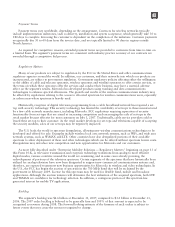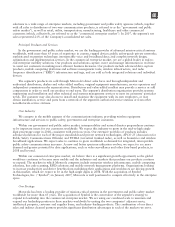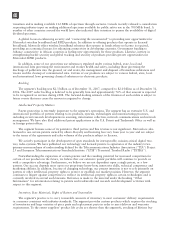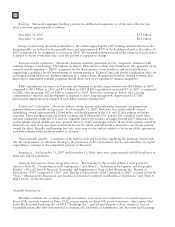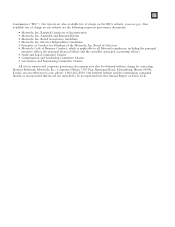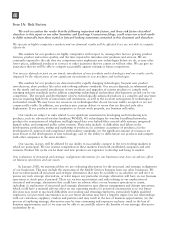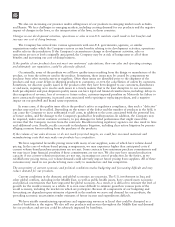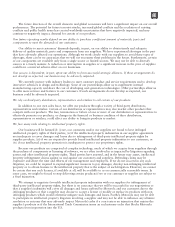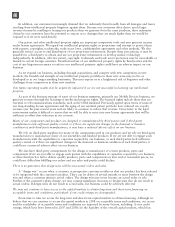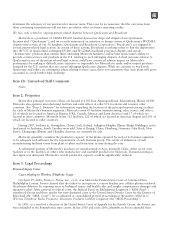Motorola 2007 Annual Report Download - page 27
Download and view the complete annual report
Please find page 27 of the 2007 Motorola annual report below. You can navigate through the pages in the report by either clicking on the pages listed below, or by using the keyword search tool below to find specific information within the annual report.
We have taken, and continue to take, cost-reduction actions. Our ability to complete these actions and the impact
of such actions on our business may be limited by a variety of factors. The cost-reduction actions, in turn, may
expose us to additional production risk and have an adverse effect on our sales and profitability.
We have been reducing costs and simplifying our product portfolios in all of our businesses. We have
discontinued product lines, exited businesses, consolidated manufacturing operations, increased manufacturing
with third parties and reduced our employee population.
The impact of these cost-reduction actions on our sales and profitability may be influenced by factors
including, but not limited to: (i) our ability to successfully complete these ongoing efforts; (ii) our ability to
generate the level of cost savings we expect or that are necessary to enable us to effectively compete; (iii) delays in
implementation of anticipated workforce reductions in highly-regulated locations outside of the United States,
particularly in Europe and Asia; (iv) decreases in employee morale and the failure to meet operational targets due
to the loss of employees; (v) our ability to retain or recruit key employees; (vi) the adequacy of our manufacturing
capacity, including capacity provided by third parties; and (vii) the performance of other parties under contract
manufacturing arrangements on which we rely for the manufacture of certain products, parts and components.
All of our businesses have consolidated or exited certain facilities and our products are now manufactured in
fewer facilities than in the past. While we have business continuity and risk management plans in place in case
capacity is significantly reduced or eliminated at a given facility, the reduced number of alternative facilities could
cause the duration of any manufacturing disruption to be longer. As a result, we could have difficulties fulfilling
our orders and our sales and profits could decline.
The demand for our products depends on the continued growth of the industries in which we participate. A
market decline in any one of these industries could have an adverse effect on our business.
The rate at which the portions of the telecommunications industry in which we participate continue to grow is
critical to our ability to improve our overall financial performance and we could be negatively impacted by a
slowdown. Our business was very negatively impacted by the economic slowdown and the corresponding
reduction in capital spending by the telecommunications industry from 2001 to 2003.
Our customers and suppliers are located throughout the world and, as a result, we face risks that other companies
that are not global may not face.
Our customers and suppliers are located throughout the world and approximately half of our net sales are
made to customers outside the U.S. In addition, we have many manufacturing, administrative and sales facilities
outside the U.S. and more than half of our employees are employed outside the U.S. Most of our suppliers are
outside the U.S. and most of our products are manufactured outside the U.S.
As with all companies that have sizeable sales and operations outside the U.S., we are exposed to risks that
could negatively impact sales or profitability, including but not limited to: (i) tariffs, trade barriers and trade
disputes, customs classifications and certifications, including but not limited to changes in classifications or errors
or omissions related to such classifications and certifications; (ii) changes in U.S. and non-U.S. rules related to
trade, environmental, health and safety, technical standards & consumer protection; (iii) longer payment cycles;
(iv) tax issues, such as tax law changes, variations in tax laws from country to country and as compared to the
U.S., and difficulties in repatriating cash generated or held abroad in a tax-efficient manner; (v) currency
fluctuations, particularly in the Euro, Chinese renminbi and Brazilian real; (vi) foreign exchange regulations, which
may limit the Company’s ability to convert or repatriate foreign currency; (vii) challenges in collecting accounts
receivable; (viii) cultural and language differences; (ix) employment regulations and local labor conditions;
(x) difficulties protecting IP in foreign countries; (xi) instability in economic or political conditions, including
inflation, recession and actual or anticipated military or political conflicts; (xii) natural disasters; (xiii) public
health issues or outbreaks; (xiv) changes in laws or regulations that adversely impact benefits being received by the
Company; and (xv) the impact of each of the foregoing on our outsourcing and procurement arrangements.
Many of our products that are manufactured outside the U.S. are manufactured in Asia. In particular, we have
sizeable operations in China, including manufacturing operations, and 7% of our net sales are to customers in
China. The legal system in China is still developing and is subject to change. Accordingly, our operations and
orders for products in China could be adversely impacted by changes to or interpretation of Chinese law. Further,
if manufacturing in the region is disrupted, our overall capacity could be significantly reduced and sales or
profitability could be negatively impacted.
19


